I took 10 days off work in the middle of Elaine’s summer holidays so we could have a tour of Scotland. Summer was the only time that seemed at all logical. Just 3 weeks before we had seen on TV all the golfers heavily wrapped in coats and jerseys for a tournament up there. If it’s that cold at the beginning of summer, it must be awfully cold the rest of the time and completely miserable in winter.
When you see the weather conditions in Scotland on the News and compare them every night to our own in St Albans, it gives you this resolute conviction not to go there, but Elaine was dead keen because that’s where the Campbells, Waughs and Maxwells of her family come from and she very much wanted to see her cousins in the Scottish Borders area. We had only just finished moving in to our new flat on the Saturday and we simply left all the mess behind and hit the road on Monday morning.

Moving in. Our new flat
We took lots of warm clothes and weather-proof gear, our AA Road Atlas of Great Britain that Thelma and Sheila gave me on my 50th birthday, Genevieve’s Lonely Planet Britain, and my nice new Fuji Finepix S602z digital camera. I had purchased a 128MB memory card for it so I was hoping the card would store all the pictures from the whole holiday. It did, easily.
We thought we’d go up the east coast and come home down the west coast, so that meant dropping onto the M1 just north of Redbourn, about 10 miles out of St Albans, and heading for Leeds. The nominal speed limit on the motorways is 70mph, but if you stay on that speed, all the faster drivers – and that means almost everyone – flash their lights at you in your mirrors to get you out of their lane. The truck drivers are professional and very polite; they let you into their lane and they always signal in plenty of time before changing lanes. Driving on the motorway means covering distance quickly, but you don’t get much of a view. Long stretches of road are lined with big trees or artificial windbreaks to stop the trucks getting blown over, so you only see the changing landscapes of different counties in brief flashes.
I’d had a most amusing discussion on the Friday “Oh, where’s your depot located?” I had asked a chap while I was resetting his printer.
“‘ull,” he said.
“And what’s the weather like up in Hull?”
“Grey. Overcust.”
“It’s lovely here in London, you know. There’s sunshine and clear skies.”
“We’ve got grey. Lots of northern grim. We don’t go in for sunshoine oop ‘ere you know.”
“I’ll look out for it when I’m driving past.”

A taste of Northern Grim
We didn’t have to; when Nottingham came up on our right, it started to rain and heavy black clouds rimmed the horizon to the east. The water from the trucks ahead showered over us and heavy winds buffeted our little Rover. “Looks like we’re getting into your friend’s Northern Grim,” said Elaine and all the way past Sheffield and almost to Leeds we fought the rain and the wind on the motorway. When you get to Leeds, the M1 simply disappears and it becomes the plain old A1. Sometimes it’s dual carriageway and sometimes it’s 4 lanes, but there’s been a bit of work done on some stretches and parts of it are quite classy with new grass banks and clear hard shoulders. I realised I could see clearly; there was even some weak sunshine.
“Is that it for northern grim?” said Elaine.
“It could be for the ‘ull version of it, but there’s plenty of North to go.” There were large signs appearing with warnings about long delays ahead, but so far the A1 was clear. We stuck with it until we were almost at the A1(M), a stretch of the A1 improved to motorway standard and under motorway driving rules. There we stopped, along with thousands of other cars in two undulating rows ahead of us and a long tail beginning to grow behind us.
“Oh, nice. Anywhere to pull off?” Elaine groaned.
I looked down at the map on my knee and then up into the gentle glow of early evening sunshine on low, rolling English countryside.
“Harrogate sound ok?”
“Harrogate?”
I looked up the Lonely Planet. “19th Century spa town. Fashionable, affluent, elegant. Stately Victorian terraces.”
“Lovely. And it’s late enough for us to stay there overnight. Where do we turn off?” Harrogate was absolutely beautiful.
These are the Royal Baths, now part of the Information Centre. We called in to see what there was that drew people to Harrogate and found out it was a spa town in the manner of Cheltenham.
Beautiful domed buildings in delicately crafted stone lined many of the streets and small colourful gardens dotted the public lawns. We found a very centrally located B&B right opposite the conference centre and then wandered around the middle of town looking for somewhere to eat.
This is it, on the right – behind the baskets of hanging flowers – Betty’s Kitchen. What a treat! We actually felt out of place in our travelling clothes so we went back to the B&B and changed for dinner. It was worth it. There was a quiet elegance about Betty’s Kitchen, a piano player drifted his fingers through semi-jazz tunes and he played Waltzing Matilda for us because he had guessed we were Antipodean and probably thought Australian was a good bet.
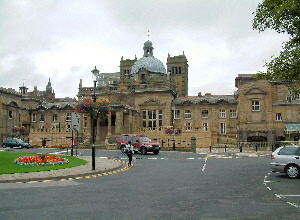
The Royal Bath House, Harrogate
We had leek soup and succulent lamb chops and a long chat with the waitress, a pretty, local girl who had a charming accent and said she was going to Sheffield University in the new term.
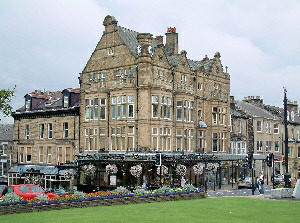
Betty’s Kitchen, Harrogate
Tue 20th In the morning we walked through the middle of this beautiful town until we found the Royal Pump House Museum. The Royal Pump House was where the very princes of society came. In late Victorian times and in the early 19th Century you came here to Take the Waters and the medicine was a shot glass of the foulest tasting sulphur water reputed to be the strongest in Europe. We had a glass, of course, but it took most of the rest of the day to get the furry feeling off our tongues and the sulphur out of our noses. The Victorian dose was eight of those glasses per day for three weeks and they bathed in the mineral waters, too, much as we do in Rotorua today. How they suffered drinking it eight times a day I cannot fathom.

The Royal Pump House, Harrogate
Our aim for today was Berwick-upon-Tweed. We discussed the road deep into the east along the coast through Scarborough, Whitby and Hartlepool. I would have loved to have gone to see Hartlepool because Chris Wheeler, a friend and workmate from London who’d helped us shift, was from there and a die-hard Hartlepool United supporter. It would have been nice to tell him we had been there. I reckoned if we took the detour, we’d be lucky to make Berwick at all today and this was a trip to Scotland. We’d have to put off exploring The North until we could come up for a week or so and do it justice. We stayed on the A1.
This is The Angel of the North. It’s a huge unpainted steel structure whose size you can gauge by the looking at the people standing at its base. It’s a fair way off the road and yet it’s still an impressive size. This is the modern marker for Gateshead, on the road to Newcastle; you simply cannot miss it. The A1 hugs the coast nicely and gave us big bites of sea views through the deep valleys and a spectacular but distant view of Alnwick Castle.
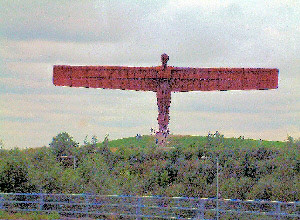
Angel of the North, Gateshead
We stopped at a pub for lunch and noticed there a sign for The Holy Island of Lindisfarne, just a few miles out of Berwick. After lunch we followed the road down to the sea and there we came across a most peculiar situation. As we came down a mild slope towards the sea, our road just kept on going and disappeared under water. A mile or so off shore the road came up again onto an island which had a castle perched on a high promontory. In the middle of the sea was a structure that looked like a bridge with thick wooden handrails. In the middle of the bridge, with one door open, was a bright red car, about the size of our Metro. There were cars parked along both sides of the road between us and the shore, with their occupants peering through binoculars at the red car on the bridge. A policeman walked back and forth from his 4×4 to the shore while his radio chortled and gargled in his vehicle.

On the causeway to Holy Island
“Does this happen every day?” I was standing in a sharp breeze close to the shore as he walked up. He looked at me speculatively, drawing his head back a little the better to see me. I guessed he was checking his mental database for the source of my accent.
“About once a week, anyway.”
“And do you always come down to check them out?”
“He could have made it if he’d got that far because the water between the bridge and here is not as deep as the water between the bridge and the island. But they see the water in front of them and they stop on the bridge. The water is very fast, you know. He can get washed off that bridge; he’s not necessarily as safe as he thinks he is.”
“Why did he get caught?” The policeman looked me over again.
“If I knew that, I’d answer some of the riddles of the universe.” He grinned. “You see the tide times? That white board over there?”
“You mean next clear causeway time is 1730 today?”
“Yup. The times on there give you a full hour of grace. If it says be off the island by 6:00pm tonight, you’re actually reasonably safe till 7:00pm. This idiot has missed even that.”
I put my camera on full zoom and peered intently at the little red car. “The water is up to the middle of his wheels. Does it get any higher than that?”
“You see the rails on the bridge? I’ve seen them disappear. With the water that high, it would wash away a big 4×4 like mine.” He looked at the car on the bridge, “He’s lucky it’s an exceptionally low tide.”
He looked steadily at me one last time. “Yeah, I come and check them out every single time.”

Tweed rail viaduct
There was no point hanging around until 1730 so we drove into Berwick-upon-Tweed, crossing the river on a spectacularly high bridge next to an equally spectacular rail viaduct over the famous River Tweed. We found a B&B in the middle of town called the Cobbled Yard. It was a bit run-down with an odd musty smell and not enough yard for our car. The maid was a dumpy, middle-aged woman in a cotton floral frock with a blue smock. Her greying, curly hair was tousled from a full morning’s cleaning. She took us up two flights of a tiny, steep, winding staircase. “Is this ok?” she asked, wheezing slightly from the exertion of the stairs. “It’s very nice,” said Elaine and we dumped our gear, paid for our room in advance and went out to explore Berwick.
It’s a town that’s typical of the Borders area. It isn’t in Scotland now, but it has been many times. Berwickshire is in Scotland and Berwick is just outside its modern borders, but the Berwick football team
plays in the Scottish League. We were only able to get a brief look at the Elizabethan ramparts that surround the town but it seems they are the main reason the town stayed English after all those adventures while being Scottish.

Berwick Town Hall
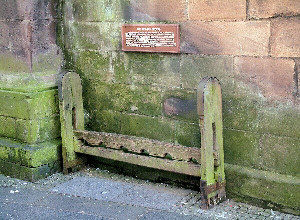
Berwick stocks

Elizabethan ramparts, Berwick
They were built by Elizabeth 1st in the 1550’s and were a very effective town defensive system. In the very middle of the main street was the Town Hall. It was built and paid for by the mayor of Berwick in the late 1700’s. It’s a remarkable building, all the more so because a later mayor in the 1840s completely renovated it. The Victorians had a deep sense of civic duty.
The stocks above aren’t used any more, of course, and the original stocks taken from here are in the town museum but this is where they were sited. What an awful thought to be in there. It was a cold, wet, windy little hole – look at the vertigris on the blockwork – and the locals were allowed to taunt you and throw things at you as they went past. However there wasn’t a lot of Berwick to see; besides it was close to 5:30pm so it was time to go to Lindisfarne.
It was a short drive out of town along the A1 and then down the narrow road to the Lindisfarne causeway, this time fully exposed all the way to the island and completely dry from having been quietly toasted in the late afternoon sun. The most striking thing about the island on first glance is the steep crag with a small castle on top so built into its fabric as to appear to have grown there out of the living rock. We parked the car, paid the toll and walked a sealed road into the village. A sign announced Lindisfarne Village, population 160. There were two pubs and two stores. This is one of the wonders of the English way of life; the tide brings people to this island in a circular kind of pattern. When there’s water over the causeway no-one can come or go, so visitors arrive here in large clumps at regularly rotating times of day according to the tide tables. The shops, however, are open 9:00am to 5:30pm. It was 6:00pm so they were closed even though the tide had just brought in 300 or so people to explore.
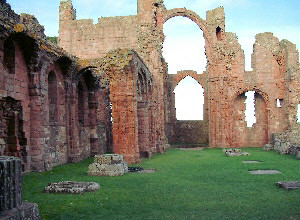
Lindisfarne Priory

St Cuthbert near Lindisfarne Priory
We found one man had who a small place open and he was doing a roaring trade. We called in there briefly. Tradition has it that Lindisfarne Mead used to be made by the monks of the priory, and this chap was selling it but I noticed the label on the bottle said 14.5% alcohol by volume. Now that would put you on your ear in a hurry. The afternoon had turned bright sunny and quite warm. We walked on through the village and explored the dramatic ruins of the Benedictine priory, in front of which stood a stone statue of St Cuthbert holding a torch and a shepherd’s crook, his head framed as with a halo by a Celtic cross.
Lindisfarne was one of the cradles of British Christianity. This priory wrote the Lindisfarne Gospels, so beautifully decorated and embellished as to be almost magical. Some of the detail on some of the pages is so intense you need a magnifying glass to appreciate its intricacies. St Mary’s Church right on the priory doorstep was
another of those beautiful little Norman churches not altogether enhanced by repairs and modernisation carried out by the Victorians. There is a wall that has a Saxon arch – this little church has deep roots. In front of the altar is a wonderful piece of carpetmaking by the local women wherein they have reproduced a page from the Lindisfarne Gospels, with large doses of brilliant red and shining gold.
I walked through the priory ruins, and watched the golden evening sunshine washing over the little harbour at the very door of the church and walked out onto a sealed road towards Lindisfarne Castle.
When Henry V111 dissolved the monastries in the 1550’s, he took the treasures from the inside of the priory and built this castle on the crag from its stones as one of his northern defences against the Scots.
It’s now owned by the National Trust after having been a coastguard station for a while and was a private residence from the 1880’s. When I got to the castle it was closed but I had caught up with Elaine and we stood on the highest step with a small group of people who had all missed the opening time of the castle and admired the commanding view we had of a very long stretch of coast.
Across the inlet to the harbour was a small stone building and more or less in front and behind it were two tall, tapering towers. “What are the obelisks for?”
The lady behind me had said exactly what I was thinking. “And I wonder how old they are?” I asked. As we walked back down the road I walked past a Coast Ranger in a bright yellow safety jacket. “Do you know what the obelisks are all about?” I asked him.
“When you are out at sea and you’re preparing to enter the harbour, you line those two towers up and head straight along that line. Now, about here somewhere,” and he pointed into the estuary directly in front us, “you’ll see the trig marker.” He waved to his right at a land point we couldn’t see, “and the moment you can see it you change direction and head for it until you are in the sheltered harbour next to the priory. That way, you stay in the channel.”
“When did they go up?” I asked
“In the 1840’s, I think. They have been there quite a while.”
“What a beautiful afternoon,” I said. “And it’s nice and warm. I was expecting cold, rain and plenty of clouds.” I told him my story about Northern Grim in my rather poor best Northern accent. He grinned knowingly.
“We say up here,” he said, “that the Geordie celebrates only two days in the year: one’s his birthday and the other’s summer.”
He waited until I finished laughing and he said, “Are you going on to Scotland?” I nodded. “No traffic jams up there, you know. Not like here. As soon as you stop, someone’s on your tail beeping at you. Once you get up into the real rural Scotland you’ll hardly see any cars at all.” The last picture I took was this intriguing view. These are upside down fishing boats. They are pretty big, too. In the transom the villager has cut a door, inside is his workshop and thus he has made the Lindisfarne shed.

Lindisfarne boat-shed
Back at the Cobbled Yard the menu was far too expensive, and not very exotic to command such prices, so we had fish’n’chips at a nearby pub.
Wed 21st We rang Edith Scott, Elaine’s grandmother’s cousin. “She is Grandma Maxwell’s first cousin,” Elaine said authoritatively, “and she lives in East Fishwick.” Edith was delighted to hear from us when we rang her from the car. We thought we’d be there about 10:30am. “I shall be able to take you to some of the places your family knew well in the Borders,” she said. Then she told us how to get to her place – next road on your right after the maize maze. “The maze maze?” I asked Elaine.
“No, the maize maze. Someone out there has cut a maze into his maize crop. People are going there and paying a couple of quid each to walk through it. He’ll probably make more money out of the maze than out of the maize.” She grinned broadly and we drove through a beautiful sunny morning towards the Scottish Borders.
This is our first view of Scotland. I thought it was pretty evocative; the highland cattle in the foreground and the heather blooming on the hill in the background. What struck us really strongly, though, and never went away, was how similar this country was to New Zealand. Almost everywhere we went, we could see a piece of the North Island in the landscape. Look at this picture – except for the heather, this could be anywhere in the Waikato. There are few places in England where you say, “Here’s a piece of home in this view,” but in Scotland you hear yourself saying it all the time. It was one of the enduring themes of our visit, how a particular view looked like a stretch of the Desert Rd, or driving alongside the Waikato River, or the Western Access Rd, it was almost uncanny.

Highland cattle and heather-covered hills
We called in at a stone cottage and asked the way. “Edith Scott? Keep on this road and she’s in the next house on your right.”
Of course we took several wrong turnings getting to Edith’s and when we got to the sign for the Maize Maze, we turned down the next road and ended up alongside the Tweed, with cars in front and cars behind, queueing up for the maze. It didn’t look possible to get to Edith’s from there so we carefully crawled back up the narrow dirt road, dodging the 4×4’s that now seem to be obligatory transport if you have a rural turn of mind.
Edith was welcoming and absolutely delighted to see us. We had been warned that she might be frail or easily tired and to be careful not to overtax her. She made us a cup of tea and wheeled it in on a little trolley. She was recently out of hospital from having her knee operated on so she moved slowly and with great care. She sat with Elaine for an hour or more while she told family stories.
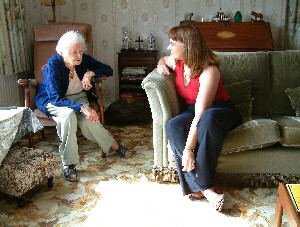
Edith Scott and Elaine
“This was all our farm,” she said. The man who told you how to get here lives in one of the farm cottages. We lived in that cottage when we’d sold the farm and we were building this house.”
I looked out the kitchen window. “Is that huge hay stack part of it?”
“It’s not hay,” she said. “It’s straw. It’s used for nesting and horse beds and cow barns during the winter. And yes, that field was part of our farm.”
“Do you mean oat straw or barley?”
“Oat straw.”
“What do they do with the oats?”
There was a pause. “Rolled oats. Porridge, Dear.”
I have put on this page a collection of the photos I took to show what Edith was like and her lovely house that she called Strathmore, set deep in the Scottish countryside. Who else would have curling stones at their front door?
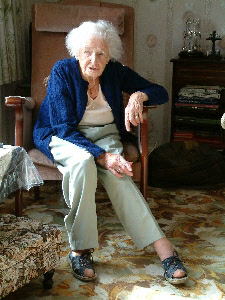
Edith Scott in her living room
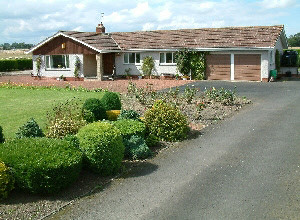
Strathmore
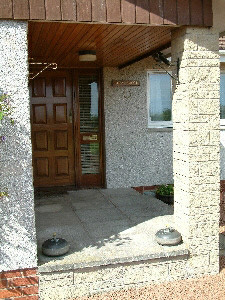
Front door with curling stones



















